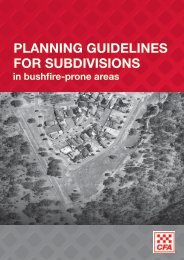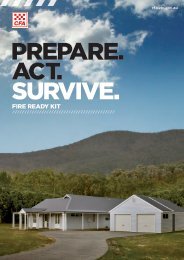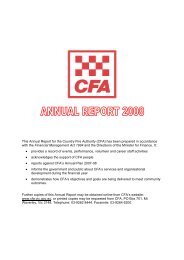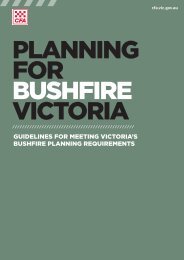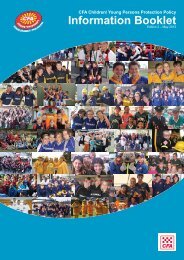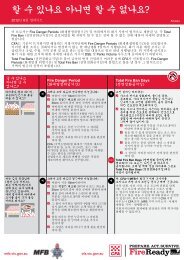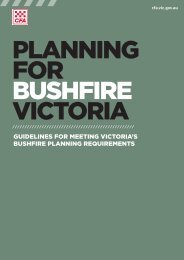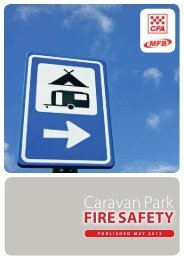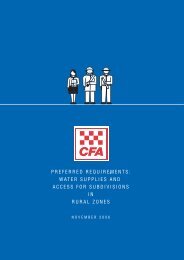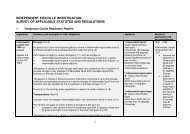Training Specifications and Guidelines - Country Fire Authority
Training Specifications and Guidelines - Country Fire Authority
Training Specifications and Guidelines - Country Fire Authority
Create successful ePaper yourself
Turn your PDF publications into a flip-book with our unique Google optimized e-Paper software.
Forest Industry Brigade<br />
<strong>Training</strong> Specification <strong>and</strong> <strong>Guidelines</strong><br />
AUSTRALIAN QUALITY TRAINING FRAMEWORK<br />
Background<br />
The competency st<strong>and</strong>ards used by CFA are drawn from a number of nationally endorsed training<br />
packages including the Public Safety <strong>Training</strong> Package (PSTP). This allows the firefighter in any state<br />
to progress through a curriculum <strong>and</strong> gain accreditation which is recognised nationally. In addition, the<br />
framework allows for accreditation in add-on skills <strong>and</strong> knowledge in specific areas, one of which is<br />
plantation firefighting.<br />
All CFA training is competency based <strong>and</strong> in accordance with st<strong>and</strong>ards set by the industry at a<br />
national level. It is appreciated that many companies which have formed FIBs also has a similar<br />
situation associated with the training of its personnel.<br />
As a Registered <strong>Training</strong> Organisation (RTO) operating under the Australian Quality <strong>Training</strong><br />
Framework (AQTF) st<strong>and</strong>ards values the skills <strong>and</strong> knowledge gained by members. CFA uses the<br />
recognition of prior learning (RPL) <strong>and</strong> recognition of current competency (RCC) as part of our skills<br />
recognition system. RPL <strong>and</strong> RCC are an integral part of a competency based educational <strong>and</strong> training<br />
system. These processes recognise the competencies which people already possess through formal<br />
study, work experience or life experience.<br />
CFA reserves the right to develop <strong>and</strong> implement specialist courses <strong>and</strong> programs to meet identified<br />
risks. The Plantation <strong>Fire</strong>fighting programs have been developed to meet the specific risks identified in<br />
plantations.<br />
Personnel operating within the plantation environment are required to satisfy the wildfire firefighter<br />
competencies for their level plus specialist plantation competencies.<br />
Application of the AQF framework within CFA<br />
These tables describe roles <strong>and</strong> responsibilities for each role within the framework.<br />
Plantation <strong>Fire</strong>fighter (AQF Level 2)<br />
Role To work under the supervision of the Crew Leader as part of a team.<br />
Responsibilities To safely, effectively <strong>and</strong> efficiently carry out allocated tasks.<br />
Crew Leader (AQF 3)<br />
Role To task <strong>and</strong> supervise the crew (sized appropriately in number to carry out their allocated task) in<br />
accordance with the Incident Action Plan, considering safety <strong>and</strong> welfare of personnel as the first<br />
priority. To continually evaluate <strong>and</strong> report on the current <strong>and</strong> future situation, monitor <strong>and</strong> review the<br />
effectiveness of tasks <strong>and</strong> tactics, <strong>and</strong> communicates up <strong>and</strong> down the chain of comm<strong>and</strong>.<br />
Responsibilities Overall management <strong>and</strong> supervision of the crew when allocated, available <strong>and</strong> out of<br />
service. To have the appropriate skills to ensure all personnel under their control work safely, effectively<br />
<strong>and</strong> efficiently.<br />
Incident Controller Level 1 (AQF 3)<br />
Role Act as Incident Controller at a Level 1 incident. To continually evaluate <strong>and</strong> report on the current<br />
<strong>and</strong> future situation, monitor <strong>and</strong> review the effectiveness of tasks <strong>and</strong> tactics.<br />
Responsibilities Overall management <strong>and</strong> supervision of the crew when allocated, available <strong>and</strong> out of<br />
service. To have the appropriate skills to ensure all personnel under their control work safely, effectively<br />
<strong>and</strong> efficiently to achieve planned objectives <strong>and</strong> outcomes using AIIMS <strong>and</strong> in accordance with Chief<br />
Officer’s St<strong>and</strong>ard Operating Procedures <strong>and</strong> Chief Officer’s St<strong>and</strong>ing Orders.<br />
Edition 2,<br />
May 2008 Safety First Page 4



